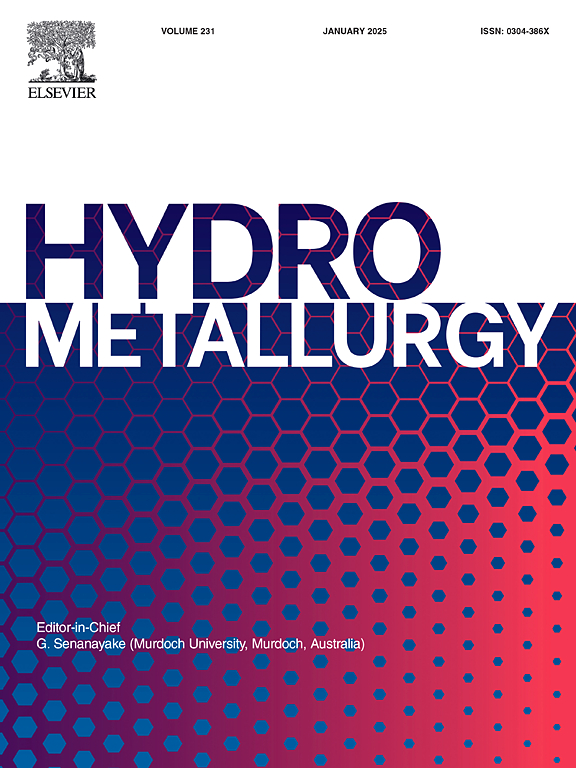黑云母硫酸浸出过程中铷的迁移及矿物相变化研究
IF 4.8
2区 材料科学
Q1 METALLURGY & METALLURGICAL ENGINEERING
引用次数: 0
摘要
酸浸从云母中提取铷和锂具有操作简单、降低能耗和提高效率等优点。然而,以往的研究主要集中在Li的浸出行为和机制上,而对Rb在云母中的晶格占位及其对浸出机制的影响的研究较少。研究了不同因素对黑云母硫酸浸出Rb的浸出效率和行为的影响。通过密度泛函理论(DFT)分析了Rb转移的机理。在优化条件下,Rb浸出率可达93.8%。DFT分析表明,在黑云母(K(Mg,Fe)3AlSi3O10(F,OH)2)层中,Rb取代发生在钾位点,并优先占据六元四面体环质心。在黑云母硫酸浸出过程中,H+通过与Rb+和K+的离子交换,首先渗透到(001)晶体表面。然后它腐蚀氧化铝四面体,导致Al3+的释放。最终,八面体层通过H+诱导的FeO键裂解发生结构解体,释放出Fe2+物质。这些发现为开发从含Rb云母中提取Rb的新一代酸浸技术奠定了基础。本文章由计算机程序翻译,如有差异,请以英文原文为准。
Research on the migration of rubidium and mineral phase changes during sulfuric acid leaching of biotite
Acid leaching has been widely employed for the extraction of rubidium (Rb) and lithium (Li) from mica owing to operational simplicity, reduced energy consumption, and enhanced efficiency. However, previous investigations have primarily focused on Li leaching behavior and mechanisms, with limited attention paid to understanding the lattice occupancy of Rb in mica and its influence on the leaching mechanisms. This study examined the effects of various factors on the leaching efficiency and behavior of Rb in sulfuric acid leaching of biotite. The mechanisms of Rb transfer were elucidated through density functional theory (DFT) calculations. Under optimized conditions, Rb leaching efficiency reached 93.8 %. The DFT analyses demonstrated that Rb substitution occurred at potassium sites within biotite (K(Mg,Fe)3AlSi3O10(F,OH)2) layers, with preferential occupation of the six-membered tetrahedral ring centroids. During sulfuric acid leaching of biotite, H+ initially penetrates the (001) crystal surface through ion exchange with Rb+ and K+. It then corrodes the aluminum oxide tetrahedron, resulting in the release of Al3+. Ultimately, the octahedral layer undergoes structural disintegration through H+ induced cleavage of Fe![]() O bonds, releasing Fe2+ species. These findings offer valuable insights and lay the foundation for developing next-generation acid leaching techniques for extracting Rb from Rb-bearing mica.
O bonds, releasing Fe2+ species. These findings offer valuable insights and lay the foundation for developing next-generation acid leaching techniques for extracting Rb from Rb-bearing mica.
求助全文
通过发布文献求助,成功后即可免费获取论文全文。
去求助
来源期刊

Hydrometallurgy
工程技术-冶金工程
CiteScore
9.50
自引率
6.40%
发文量
144
审稿时长
3.4 months
期刊介绍:
Hydrometallurgy aims to compile studies on novel processes, process design, chemistry, modelling, control, economics and interfaces between unit operations, and to provide a forum for discussions on case histories and operational difficulties.
Topics covered include: leaching of metal values by chemical reagents or bacterial action at ambient or elevated pressures and temperatures; separation of solids from leach liquors; removal of impurities and recovery of metal values by precipitation, ion exchange, solvent extraction, gaseous reduction, cementation, electro-winning and electro-refining; pre-treatment of ores by roasting or chemical treatments such as halogenation or reduction; recycling of reagents and treatment of effluents.
 求助内容:
求助内容: 应助结果提醒方式:
应助结果提醒方式:


